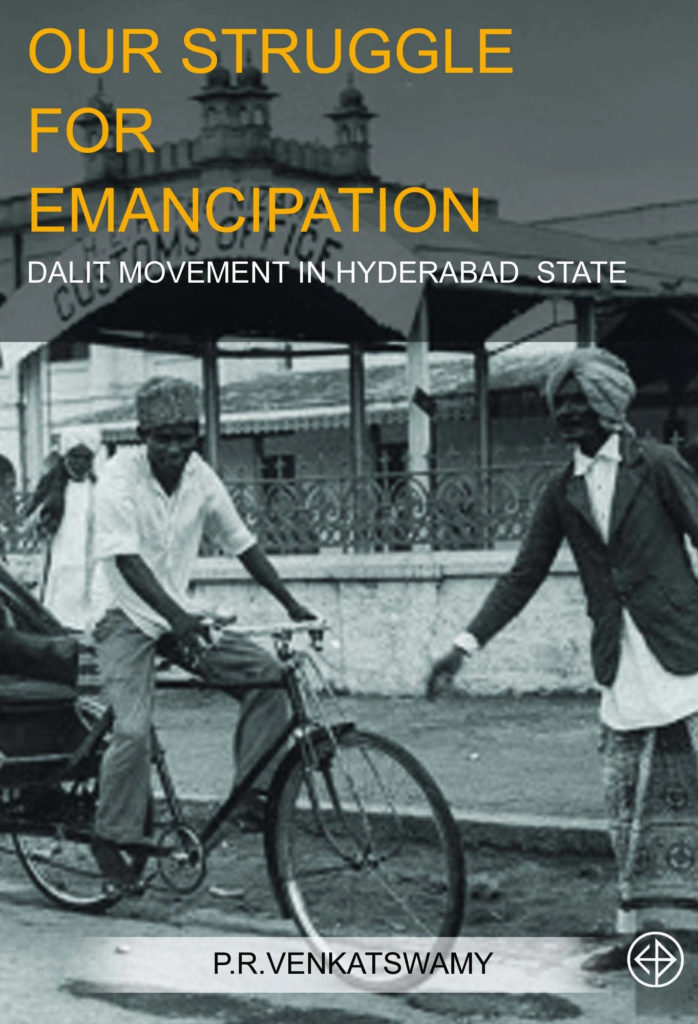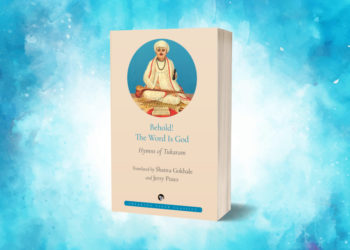Our Struggle for Emancipation: The Dalit Movement in Hyderabad State, 1906-1953 (Hyderabad Book Trust, 2020) by P R Venkatswamy, details the history of the dalit movement in Hyderabad State. The book spans from Nizam’s rule, opposition to it from the Congress and Andhra Mahasabha, the rise of small-scale organisations of the dalits, their metamorphosis into a full-blown anti-Hindu movement, the rise of Razakars to the take-over of Hyderabad State by the Indian Union. The movement was closely linked to Ambedkar and opposed Congress and the Gandhians. The author, Venkatswamy, participated in the movement, which was not just about reforming caste cultures but also about asserting the rights of the dalit castes.
The following are two excerpts from the book.

The Population
The population of our people in the Dominion of Hyderabad was about 19 lakhs which was nearly 20% of the Hindu population and 18% of the total population of the State. There were 34 sub-castes which were generally known as Mala, Madiga in Telangana and Dhed, Mang and Mahar in Marathwada. The total percentage of literacy in the Dominions was only 21% and among the untouchables, it was infinitesimal.
The occupation of our people in the villages was field labour and free labour (forced labour) and in the city of Hyderabad and the town of Secunderabad, it was domestic service in European and Muslim households. There were also leather workers, scavengers and masons among them. Many were employed in the Railways and government departments and in private workshops. There were a few well-to-do contractors and artisans too. They adopted all Hindu customs in their auspicious and inauspicious ceremonies and consequently all the evils of Hindu society were copied by them. They even observed untouchability among the sub-castes. There was no inter-dining or inter-marriage among these castes. The greatest evil which sapped the very vitals of their economic structure was the evil of drink which was extensively practised on occasions of religious and social ceremonies.
[…]
Dedication of Devadasis
One of the laudable services of Bhagya Reddy to the community was the prevention of the dedication of Devadasis who led a disgraceful life of prostitution. He founded an organization under the name ‘Adi-Hindu Murali Nivarana Mandali’ to put a stop to prostitution. He took the help of government in suppressing this hereditary practice and conferred an everlasting boon on the community. But still some orthodox families followed this practice in secret and performed the ceremony of dedication in remote places away from the town. Such ceremonies were kept top secret and only the nearest of kith and kin were invited to the ceremony of dedication.
It will not be out of place if I describe an incident of one such dedication which, though it appeared to be insignificant, was a turning point in the development of our movement for the uplift of our community.
It was a Sunday of the summer season of 1925. Arigay Ramaswamy was on duty at the Secunderabad railway station. Some one brought information to him that a gang of people had clandestinely assembled in the interior of Kavadiguda forest to dedicate a girl to the Goddess. Immediately he rushed to the ‘Friends Union’ without even changing his ticket checker’s uniform, and taking along with him, Mocherla Ramanjulu, T.M. Krishna and myself who were then present in the room, hurried to Kavadiguda police station. From there, he phoned Kotwal Venkat Rama Reddy to give the assistance of some constables to help him to prevent the unlawful act of dedication of Parvathi which was prohibited by government.
Permission being granted, we set out to raid the spot followed by two constables. We penetrated the thorny thickets and proceeded in the direction of a well where the ceremony was supposed to be taking place. But to our surprise, the raid was betrayed by Arigay Ramaswamy’s dog, named ‘Tiger’, which also accompanied us and ran in advance of our party. The gang recognised Arigay Ramaswamy’s dog which was as popular as his master, and raised a signal of alarm that they were detected. By the time we reached the place they had destroyed the puja decorations on the spot where the dedication was to take place but could not remove the ceremonial dress and the ornaments of the girl who was to be dedicated. An unsheathed sword with vermilion marks and a garland of flowers, to which the girl was to be married, was lying there in the midst of the confusion. They were all caught red-handed and Arigay Ramaswamy was happy to have frustrated the evil designs of the gang which would have ruined the life of an innocent girl.
The above incident might appear a trivial affair in the history of our movement. But the later developments connected with this incident will indicate its importance. In my view it was the beginning of the creation of the disruptive elements which gradually spread all over the twin cities of Secunderabad and Hyderabad. It created a gulf between the social workers of Secunderabad and Hyderabad under the leadership of Arigay Ramaswamy and Bhagya Reddy respectively and widened this to such an extent that it became almost impossible to bridge it.
Adoption of a Madiga boy in a Mala Family
It was not the object of Arigay Ramaswamy to take criminal action against the culprits of the above incident, but to reprimand them and prevent such acts occurring in the future. The mother of the girl was convinced of her folly and to our great surprise, the girl was entrusted to the fatherly care of Arigay Ramaswamy himself. He shouldered the grave responsibility with dutiful pleasure and gave his word of honour to see her properly settled in life.
A few months after this incident Arigay Ramaswamy came across an orphan boy of the Madiga caste, who was in need of protection. As he was already on the look out for the marriage of the girl, he thought it a godsent opportunity for him to make use of this boy for the purpose. Through one of his close relatives he persuaded a Mala family which had no male issue and residing at Nowbat Pahad Military Quarters to adopt this boy into their family. He gave special instructions to see that at the adoption ceremony all the elder members of the locality including Sergeant Majors Ethirajam and Chenniah of the String Band, the devoted followers of Bhagya Reddy, should be invited and their signatures obtained on the document as witnesses. All this process was gone through as per his instructions and the adoption became an accomplished fact.
Marriage of Rescued Girl
After a gap of a fairly long period, Arigay Ramaswamy consummated the match between the adopted Madiga boy and the rescued Mala girl. Wide publicity was given to this marriage and invitations were extended to all social reformers. It was to be solemnised under the presidentship of Vaman Ramchandar Naik, a well-known social reformer of Hyderabad and Baji Krishna Rao was to officiate as purohit. The muhurtam was fixed at 10 o’ clock in the morning in the Chennakeshavaswamy temple and we made elaborate arrangements for the reception and meals, etc., as we expected a large number of guests. The marriage was significant in the sense that it was to be celebrated under the auspices of the Adi-Hindu Jatiyonnati Sabha.
Three days prior to the marriage ceremony, M.L. Audiah as President of the Adi-Hindu Jatiyonnati Sabha and trustee of the temple received a directive from Bhagya Reddy in the capacity of the secretary of the Adi-Hindu Social Service League, to stop the marriage taking place in the temple premises as the bridegroom belonged to the Madiga caste and such matrimonial alliance with Malas was prohibited in the custom of the Mala community. M.L. Audiah, without the least thought about the consequences of his action, forwarded the letter to Arigay Ramaswamy, with an endorsement not to celebrate the marriage in the temple premises. Arigay Ramaswamy wrote back to say that he would celebrate the marriage in the temple premises under any circumstances. This letter was redirected by M.L. Audiah to Bhagya Reddy for information.
This news spread like wildfire all over our localities of Secunderabad. The impression in the minds of people that Bhagya Reddy was inimical towards the Madigas had been firmly confirmed by his latest attitude. Above all, M.L. Audiah’s thoughtless attitude was resented by all young men who considered his action as a slur on social reformers of Secunderabad who were far in advance in every respect in comparison to the workers of Hyderabad. But M.L. Audiah had more regard and respect for Bhagya Reddy than his own colleagues of Secunderabad, whom he considered young and inexperienced in the field of social service.
The directive of Bhagya Reddy gave a ‘forest f ire’ publicity to the marriage and several uninvited guests, in large numbers, came to witness the function, out of curiosity to see whether any untoward incident might take place. But Arigay Ramaswamy was confident of his success. A few minutes before the muhurtam, a party of middle-aged men headed by Bhagya Reddy arrived at the temple in a private motor bus. The leader of the party protested against the celebration of the marriage with pride in his argumentative powers. Our blood was boiling with anger and a wink from our leader at the young workers would have been quite sufficient to put them to flight. But in consonance with our sense of dignity, we showed respect to them and had confidence in the logic of Arigay Ramaswamy which excelled that of Bhagya Reddy’s. He produced documentary proof of the adoption ceremony of the bridegroom which contained the signature of sergeant Major Chenniah who was in the group.
The arguments and counter arguments raged for more than three hours. In the end Bhagya Reddy and his vanquished party left the premises of the temple to the cheers of our victory. The marriage ceremony was gone through with great enthusiasm and eclat though the muhurtam was delayed by three odd hours. All seemed to have ended well, but very interesting developments followed subsequently.
Excommunication of the Participators in the Marriage Ceremony
Bhagya Reddy immediately called his omnipotent Sadar Panchayat Sabha to consider the legality of the marriage They unanimously decided to nullify the marriage and excommunicate the participators in the illegal marriage ceremony. But only a few names of the participants from the bride’s and bridegroom’s group were notified and prominent among them was Arigay Ramaswamy. Though M.L. Audiah was not present at the marriage function, he participated in the Panchayat Sabha and was a party to the decision of excommunication.
Excommunication of M.L. Audiah
To challenge this unwise decision of excommunication, we summoned our Panchayat Sabha which was now flourishing in full swing under the able guidance of Kaltoori Ramakrishna and declared our unanimous decision to excommunicate Bhagya Reddy’s party that came to the Chennakeshavaswamy temple, including their leader Bhagya Reddy, and G.R. Dakiah, the Panchayat Secretary. M.L. Audiah too shared this fate for the guilt of his thoughtless participation in the panchayat which excommunicated Arigay Ramaswamy.




